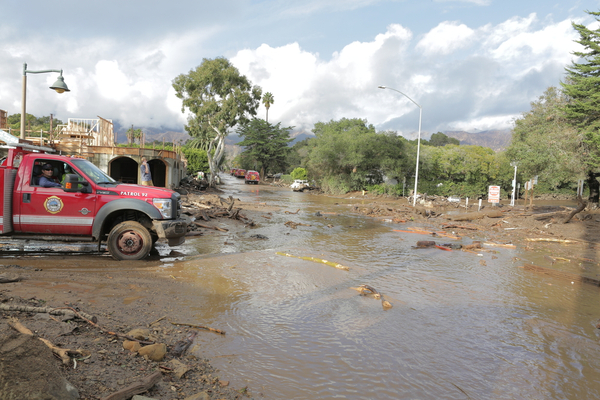The dangerous combination of extreme wildfires followed by torrential rainfall that can lead to deadly flooding and landslides will likely become more common in western states as the world becomes warmer, according to a new study. The study, just released in the journal Science Advances, found that the double threat of extreme fires and rainfall could increase by 700% in the Pacific Northwest by the end of the century and happen up to twice as often in California.
Overall, the results predict that 90% of extreme wildfire events in California, the Pacific Northwest and Colorado will be followed by at least three extreme rainfall events within five years after a fire. Researchers used climate models to analyze the risk of intense fires followed by extreme rainfall in the worst-case scenario of continued human-caused climate change. The research comes on the heels of some of the worst western wildfire seasons on record.
As weather.com explains, wildfires leave barren paths known as burn scars, which are more susceptible to an especially dangerous and fast-moving type of landslide that scientists call “debris flows” triggered by heavy rain. “One disaster is bad. Two disasters in rapid succession is even worse because you’re already reeling from the first one,” study co-author Samantha Stevenson, a climate scientist at the University of California Santa Barbara, told The Associated Press (AP).
Stevenson continued, “But in the particular case of wildfire plus extreme rain, the wildfire is setting you up for worse consequences because you’re losing your vegetation, you’re changing soil properties and making that landscape more conducive to destructive flooding.” Besides destroying vegetation that would normally hold soil and debris in place, wildfires change certain characteristics of the soil itself. It becomes less likely to absorb water, which creates conditions ripe for flash flooding and debris flows.
Known less formally as mudslides, debris flows can send a wall of water, soil, ash, vegetation, rocks and other debris careening downhill, sweeping away or burying everything in its path. Ongoing drought in the West also contributes to the risk by making extreme fire weather more likely. The type of short, intense bursts of rainfall that trigger debris flows can happen regardless of drought conditions. There are several examples of debris flows in burn scars areas in recent years, including last year along Interstate 70 in Colorado’s Glenwood Canyon and in parts of California.
In 2018, at least 20 people were killed when mudslides with walls of debris as tall as 30 feet struck the Santa Barbara County community of Montecito On average, 25 to 50 people are killed by landslides every year in the United States, according to the USGS. The scientists involved in the new study point out that previous research has already shown that wildfires will likely get worse due to climate change, and models predict more extreme rainfall in the future.
“This increase in fire-following extreme rainfall events is driven by widespread increases in both extreme fire weather conditions and high-end precip events — so it’s not just one side of the equation driving this large increase in compound events,” UCLA climate scientist and study co-author Daniel Swain tweeted Friday.
—
Photo Credit: Media Bakery13 / Shutterstock.com
